Rhode Island’s Narragansett Bay has been a hot bed of sailing, racing and boatbuilding for hundreds of years. The bay is the home to the Herreshoff family who dominated yacht design and building in the last Guilded Age and it is now, in the current Guilded Age, the home of builders like New England Boatworks and Waterline Systems that lead the way in the construction of high tech racing and cruising yachts.
The bay is home to world-class sailors and it is said that the Laser, J/24 and Shields fleets are some of the toughest one-design fleets in the country. Sailing on the bay any day during the summer you will encounter a magical sailing mix of mega sailing yachts, high-tech racing machines, vintage yachts from the past and circles of one-designs battling around the buoys. The bay is where sailors live.
So on the day that I had a chance to take the new Salona 33 out for a test sail, I was lucky enough to have aboard yacht broker and old friend Richard Barker to share the sailing duties. Richard has been a fixture in the S-Boat and J/24 fleets for a long, long time and knows his way around a performance boat with the best of them.
PERFORMANCE SAILING
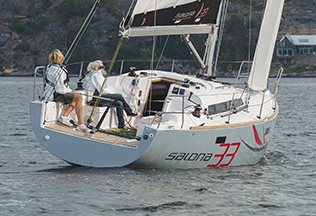 We found the 33 in her slip in a marina up the bay and quickly got her sail covers off, the engine cranked up and the sheets led. The boat we sailed had the optional twin wheels instead of a tiller, which seems like overkill for a 33 footer but actually works very well.
We found the 33 in her slip in a marina up the bay and quickly got her sail covers off, the engine cranked up and the sheets led. The boat we sailed had the optional twin wheels instead of a tiller, which seems like overkill for a 33 footer but actually works very well.
The boat backed out of the slip easily, we put her through a K-turn and avoided running aground by hugging the slips as we motored toward open water. The steering under power was positive and with the engine at cruising revs we made six knots without breaking a sweat. At full revs we got her up to just over seven knots. The 33 has a high aspect spade rudder that gives the helm a sure but very light feel.
We hoisted the fully battened mainsail and sailed for a few minutes without the jib to see how she would handle. Although underpowered, the boat can certainly be sailed, tacked and jibed under the mainsail alone, which is great news for shorthanded crews who like the reassurance that they can sail in and out of tight situations—such as a marina—without having to switch on the engine.
With the fractional 110 percent genoa rolled out, the 33 accelerated noticeably. There was a 35 foot racer-cruiser from another well-known builder sailing hard on the wind ahead of us, so Richard and I hardened up to give chase. After all, you only need two boats to make it a race.
The 33 put her shoulder down in the moderate 10 knots of breeze and charged ahead with real purpose. The J & J designed hull has a long waterline, moderate beam and high aspect keel and rudder below the water. She settled into the groove at about 32 degrees to the apparent wind and as we worked the puffs we were able to climb to windward very sweetly. After three tacks, we had overtaken the 35 footer and put it well in our lee. The 33 was decidedly higher and faster on the wind. Game over.
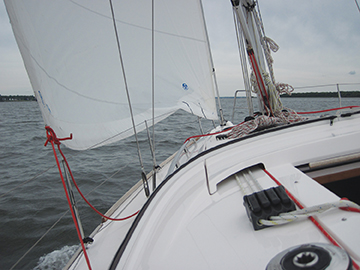 We fell off the wind and broad reached back toward the marina, sailing at about 160 degrees apparent and jibing easily to maintain our course. It was a shame we did not have the asymmetrical chute aboard; it would have been a blast to feel the slippery little boat really fly under the press of a downwind sail. As it was, we maintained six knots with the apparent wind at six knots off the quarters.
We fell off the wind and broad reached back toward the marina, sailing at about 160 degrees apparent and jibing easily to maintain our course. It was a shame we did not have the asymmetrical chute aboard; it would have been a blast to feel the slippery little boat really fly under the press of a downwind sail. As it was, we maintained six knots with the apparent wind at six knots off the quarters.
A handy, spritely boat with a good design pedigree, the new Salona 33 made two experienced sailors very happy that afternoon. The boat is well balanced and has all of the traveler, vang and sheet adjustments we needed to get her sailing optimally. The skipper of that 35 footer must have wondered what that little boat was doing rolling him so easily.
CRUISING COMFORTS
Not too long ago—or maybe quite a while ago, actually—33 feet was a normal size for a family racer cruiser, a boat that could be sailed for a week of summer vacation and raced on Tuesday nights and in regional regattas. Today, 33 feet seems quite small when you look at all of the 50 footers that young families deem necessary for their sailing pleasure.
For those on a more modest budget, they still can go sailing, still enjoy cruising and still have fun racing without having to break the bank. A 33 footer can be plenty of boat for all that.
The cockpit of the boat is well laid out for sailing and sheet handling. But it also is fairly spacious. With the twin wheels instead of the tiller, you steer from the side and have great sight lines forward. The benches are wide enough for two adults side by side and the side decks have room for four more to sit.
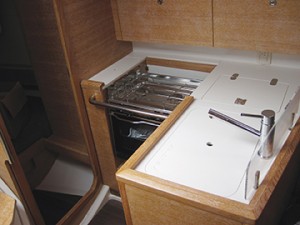 Walking forward along the side deck, you have plenty of deck width and good places to hang on in bumpy conditions. While aft, the open transom provides easy access to a dinghy or doubles as the swim platform.
Walking forward along the side deck, you have plenty of deck width and good places to hang on in bumpy conditions. While aft, the open transom provides easy access to a dinghy or doubles as the swim platform.
Down below, the 33 has two sleeping cabins. The forward cabin has a V-berth, a small bench, plenty of locker space and a hanging locker. The after quarter cabin on the port side has a spacious double berth and plenty of locker space. The boat is laid out for two couples cruising or a racing crew of five or six who also use the bench settees in the saloon as berths.
The head is in the starboard aft quarter and has all of the locker space you need plus a shower head/sink faucet combination.
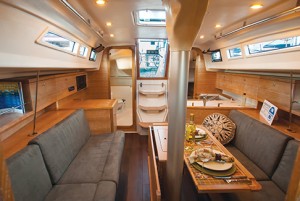 The saloon has a centerline table with folding leaves that will seat four comfortably but can accommodate six in a pinch. The chart table is a proper nav station that will fit a chart and has room to mount all of the electronics you might need. The galley has a two-burner stove-oven and plenty of locker space. The spaces are all well laid out so even with four adults below decks, you will be able to sit, eat, cook and navigate without always bumping into your partners.
The saloon has a centerline table with folding leaves that will seat four comfortably but can accommodate six in a pinch. The chart table is a proper nav station that will fit a chart and has room to mount all of the electronics you might need. The galley has a two-burner stove-oven and plenty of locker space. The spaces are all well laid out so even with four adults below decks, you will be able to sit, eat, cook and navigate without always bumping into your partners.
The standard décor of the 33 is quite traditional looking with varnished mahogany joinery and white, molded fiberglass bases. With three port lights in the hull on both sides, a lot of ambient light fills the cabin. Plus, the boat has four opening ports and two deck hatches that add to the lightness of the interior and the ventilation throughout.
The interior of the 33 is a pleasant place to live aboard and a thoughtful combination of traditional décor and modern construction.
BWS THOUGHTS
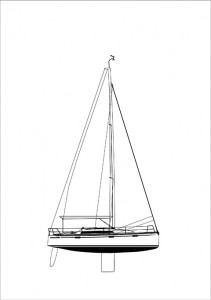 The Salona 33 is built in a modern facility in Croatia using the most modern techniques and materials. The hull is a vacuum bagged, infused laminate that is fitted with a structural grid that anchors the furniture, provide stiffness to the hull, supports the keel and offers a solid base for the keel-stepped mast. Although we did not press the 33 during our test sail, she certainly was stiff and solid underfoot.
The Salona 33 is built in a modern facility in Croatia using the most modern techniques and materials. The hull is a vacuum bagged, infused laminate that is fitted with a structural grid that anchors the furniture, provide stiffness to the hull, supports the keel and offers a solid base for the keel-stepped mast. Although we did not press the 33 during our test sail, she certainly was stiff and solid underfoot.
Although small by modern standards, the 33 is a perfect boat for young families who want to cruise and race together. It will appeal to those who want to follow the regional racing circuit and enjoy some cruising on the side. And, it will be a great boat for older cruisers who want to downsize from their large boats and get back to the essence of coastal cruising in a boat that fulfills their sailing needs.
Salona 33
LOA 33’0”
LWL 31’4”
Beam 10’4”
Displ. 11,500 lbs.
Ballast 3,500 lbs.
Draft 5’6”
Water 25 gals.
Fuel 10 gals.
Engine 21-hp.
Salona America
Coconut Grove, FL
301-504-8714
www.salona-america.com















